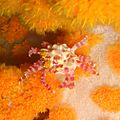Majoidea facts for kids
Quick facts for kids Majoidea |
|
|---|---|
 |
|
| The Japanese spider crab (Macrocheira kaempferi) | |
| Scientific classification | |
| Kingdom: | |
| Phylum: | |
| Subphylum: | |
| Class: | |
| Order: | |
| Infraorder: | |
| Superfamily: |
Majoidea
|
Majoidea is a large group of crabs, often called spider crabs. They are part of the bigger group of crabs known as Brachyura. These crabs are known for their long, slender legs and often have bodies that are shaped like triangles or pears. Many spider crabs also have bumpy or spiky shells.
Contents
What are Majoidea Crabs?
Majoidea is a superfamily of crabs. This means it's a big family that includes many different kinds of crabs. They are part of the infraorder called Brachyura, which includes all "true crabs." Unlike some other crabs, Majoidea crabs usually have legs that are much longer than their bodies. They also tend to walk forward or backward, instead of sideways like many other crabs.
Families of Majoidea
The Majoidea superfamily includes several important families. Each family has its own unique types of spider crabs. Here are the main families:
- Epialtidae: This family includes crabs like the candy crab, which often decorates itself with sponges or other materials.
- Hymenosomatidae: These are often very small crabs, sometimes called "false spider crabs." One example is Limnopilos naiyanetri, which is tiny.
- Inachidae: This family includes some of the most famous spider crabs, like the giant Japanese spider crab.
- Inachoididae: Crabs in this family are often found in deeper waters.
- Majidae: This is another large family of spider crabs, including the common spider crab found in many oceans.
- Oregoniidae: These crabs are often found in colder, deeper waters.
Where Do Majoidea Crabs Live?
Majoidea crabs live in many different parts of the ocean. You can find them in shallow waters near the coast, hiding among rocks and seaweed. But many types of Majoidea crabs also live in the deep sea, where it is very dark and cold. They are found in oceans all around the world, from tropical areas to polar regions. Some species prefer sandy bottoms, while others like rocky areas or coral reefs.
What Makes Majoidea Crabs Special?
Spider crabs have some very interesting features and behaviors.
- Camouflage Masters: Many Majoidea crabs are experts at hiding. They often attach sponges, seaweed, or other small sea creatures to their shells. This helps them blend in with their surroundings, making it hard for predators to spot them. It's like wearing a living disguise!
- Long Legs: Their long, slender legs help them move across the ocean floor. These legs can also help them climb over obstacles or reach for food.
- Diet: Most Majoidea crabs are scavengers. This means they eat dead plants and animals that they find on the ocean floor. They also eat algae and small invertebrates. This helps keep the ocean clean.
- Size Range: Majoidea crabs come in many sizes. Some are tiny, only a few centimeters across. Others, like the Japanese spider crab, are enormous. The Japanese spider crab can have a leg span of up to 3.7 meters (about 12 feet), making it the crab with the longest leg span in the world!
Images for kids
-
Macrocheira kaempferi, an Inachidae
See also
 In Spanish: Majoidea para niños
In Spanish: Majoidea para niños







